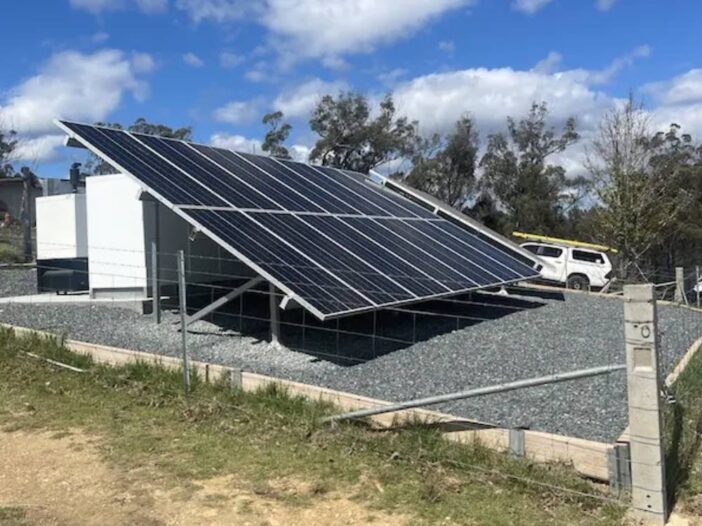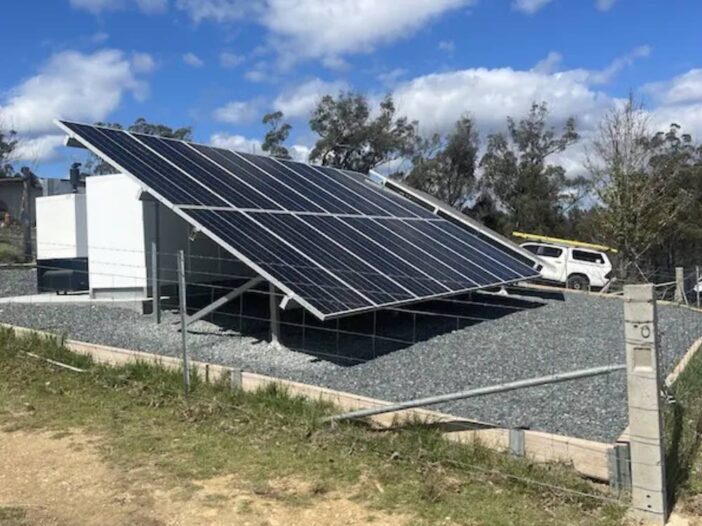Networks embrace stand-alone power as solar and batteries beat out poles and wires – One Step Off The Grid

Standalone power systems based on renewable energy and battery storage could start to become the norm on parts of Australia’s far-flung grid, as network operators turn to them as a more reliable and cheaper option than traditional poles and wires.
Two of these completely off-grid solar, battery and diesel generator systems have gone live in Bulahdelah, north of Newcastle, and another in Moruya, which is on the New South Wales (NSW) south coast.
The generators are owned and operated by state-owned network operator Essential Energy, in a process that began in 2018 as regulators grappled with how to categorise these kinds of systems when networks aren’t allowed to own energy generators.
Unlike a microgrid, which can also be connected to the grid and supplies a whole community, the standalone systems are completely disconnected from grid infrastructure and service a single customer, or perhaps two or three clustered closely together.
And while these have been trialled in NSW since 2020, NEM registration means these systems now have all of the benefits as those that is network connected, such as a full choice of electricity retailer and the same reliability requirements, says chief operating officer Luke Jenner.
“We provide exactly the same service we would if the customer was grid connected,” Jenner says.
“The reason that we do it is that it works out cheaper for all customers, because these customers are generally very remote and are fed by significant distances of lines.”
It also works out cheaper for Essential Energy which no longer has to maintain poles and wires to remote areas and clear vegetation.
Jenner says the breakeven point for these systems is the equivalent of about 3 kilometres of power lines, with one system costing about $250,000 although that figure is dependent on what the customer needs today and in the future.
Breaking that number down comes to $83,000 a kilometre, a figure that Jenner says is accurate for the more expensive to maintain lines, or those going through a highly vegetated area.
The company has about 2000 customers across the state which are economically viable to set up with a standalone power system.
Another 14 customers have signed up for a standalone power system, and Essential Energy is asking the regulator for funding for 400 over the next five years as part of its draft plan, which it expects to see final approval for in April.
Jenner expects the number of viable sites will only increase over time as the price of the off-grid systems falls and as the cost of maintaining grid infrastructure increases over time.
Starting the shift
The Bulahdelah system was originally one of the trial sites, which have been running since 2020. It has a 10.6Kw solar array, a16KWh battery and a 15KVA diesel generator.
The Moruya customer lost her home during the 2019-20 bushfires and had been using a temporary trailer-based system. That was replaced with a permanent installation with a 10.9Kw solar array, a 38KWh battery and a 15KVA diesel generator.
In late 2022 Essential Energy launched an 18 month trial of a hydrogen-based system to power a heritage cottage in the Myall Lakes National Park. The idea was to create a system that doesn’t need any fossil fuel backup at all using a system of 23kW solar panels, a lithium-ion battery, hydrogen electrolysers and fuel cells and hydrogen storage of up to 20 days (425 kilowatt hours).
Jenner says the hydrogen fuel cell trial proved it could be as effective as the solar alternative, but was twice as expensive. They are now negotiating to keep the system on site, in order to find out how it performs over the longer term.
Changing the rules
The ability to connect a standalone system into the NEM was practically only possible from mid-2023, after a rule change in August 2022 by the national rule-maker, the Australian Energy Market Commission (AEMC), a spokesperson from Essential Energy says.
The journey began in 2018, following a recommendation in the 2017 Finkel Review, aka the Independent Review into the Future Security of the NEM, and came as the AEMC and NSW’s Independent Pricing and Regulatory Tribunal (IPART) said in 2020 that changes were essential to secure electricity access for remote sites.
IPART said strict reliability standards were contributing to the increasing costs of electricity, as network operators were compelled to invest in new network infrastructure even when it delivered little value to customers and often prevented the deployment of new, lower cost, technologies.
The reforms would work to protect consumers when barriers to the use of microgrids by distribution networks are lifted, ensuring they receive the same level of service provided by maintaining a connection to the main grid.
Changes in 2020 allowed network companies to offer customers standalone power systems by using a waiver, because at the time the issue the regulator was wrangling with was whether to consider the network company a generator or not.
Western Australia’s Western Power, which has a number of standalone systems on its books and being in WA isn’t part of the NEM, suggested at the time that the AEMC expand the definition of network services to include non-grid connected systems so network providers could provide decent services to off-grid customers and pass on savings from line maintenance to all customers.
The final outcome in 2022 was to consider the standalone system as essentially part of the network, and allow these to be connected into the NEM in order to give customers the full protections of a grid connections — even if they no longer had a wire running to their property.


